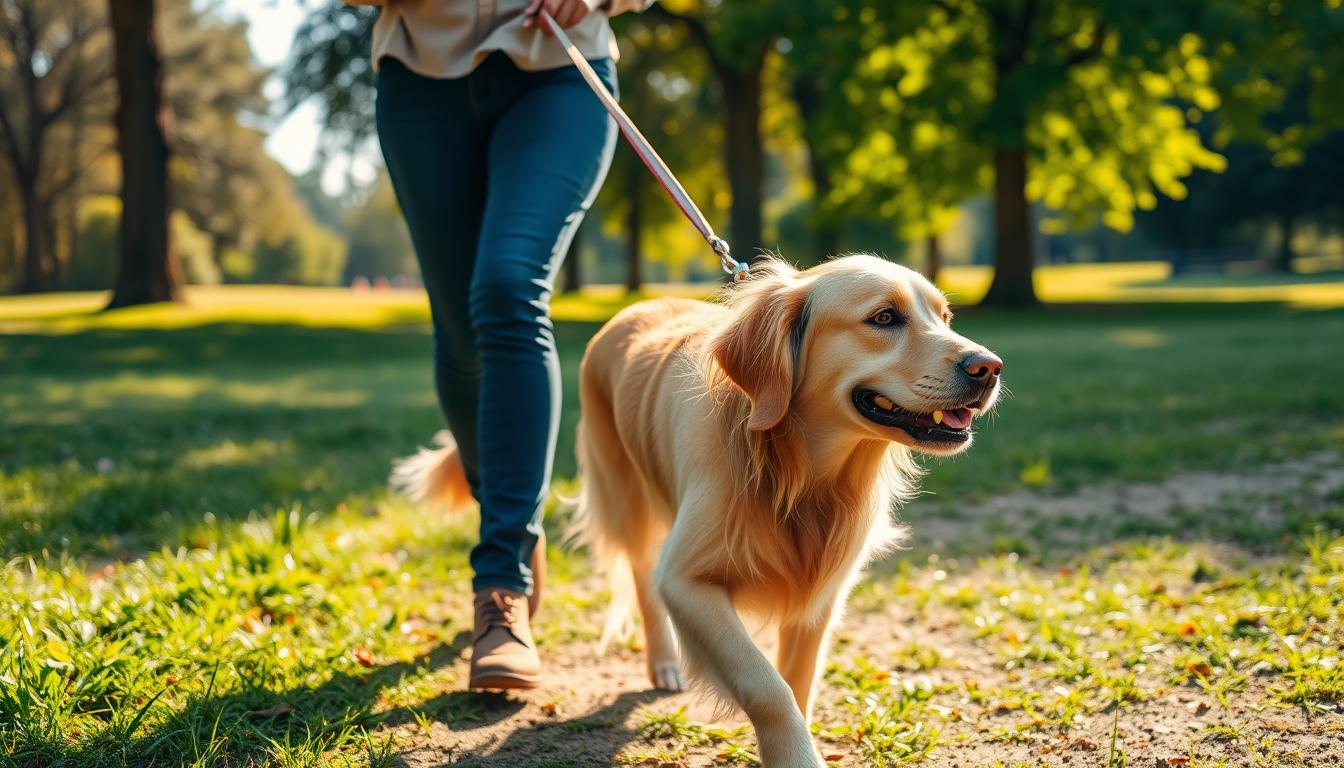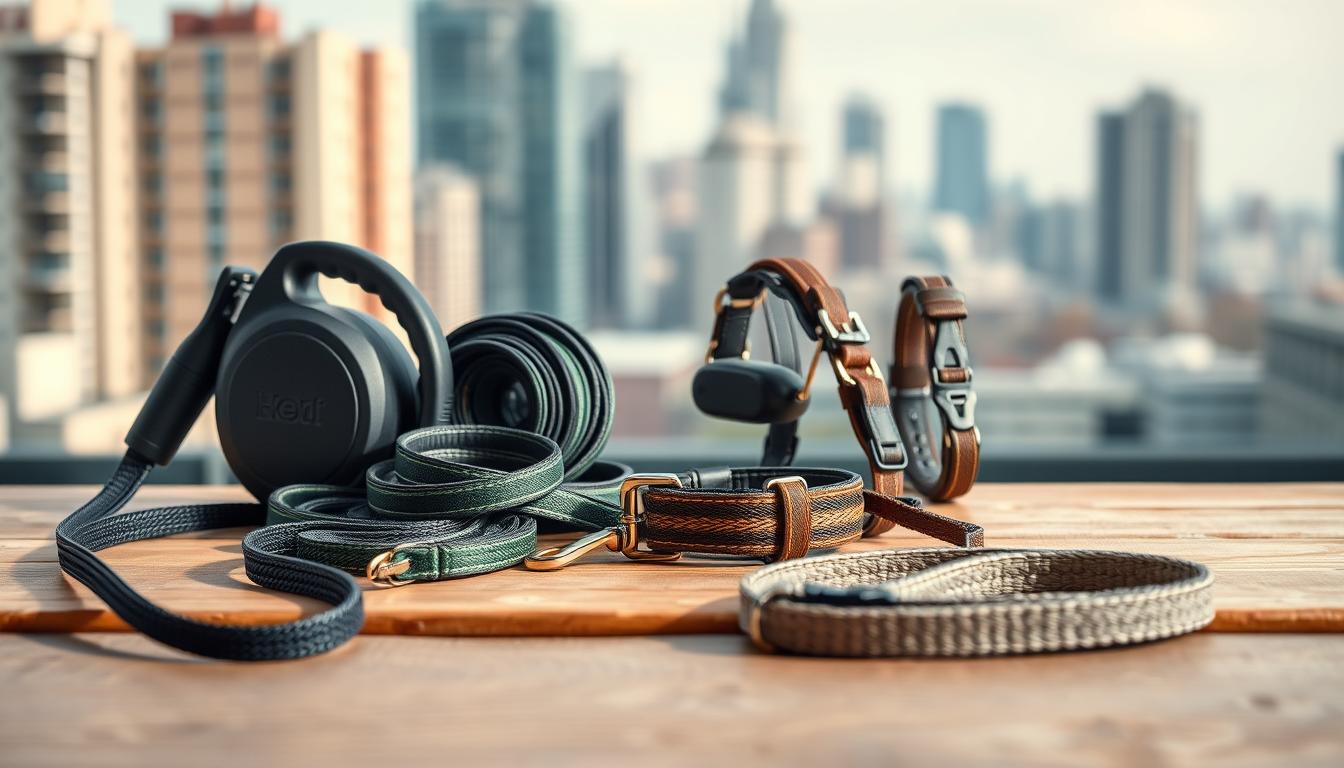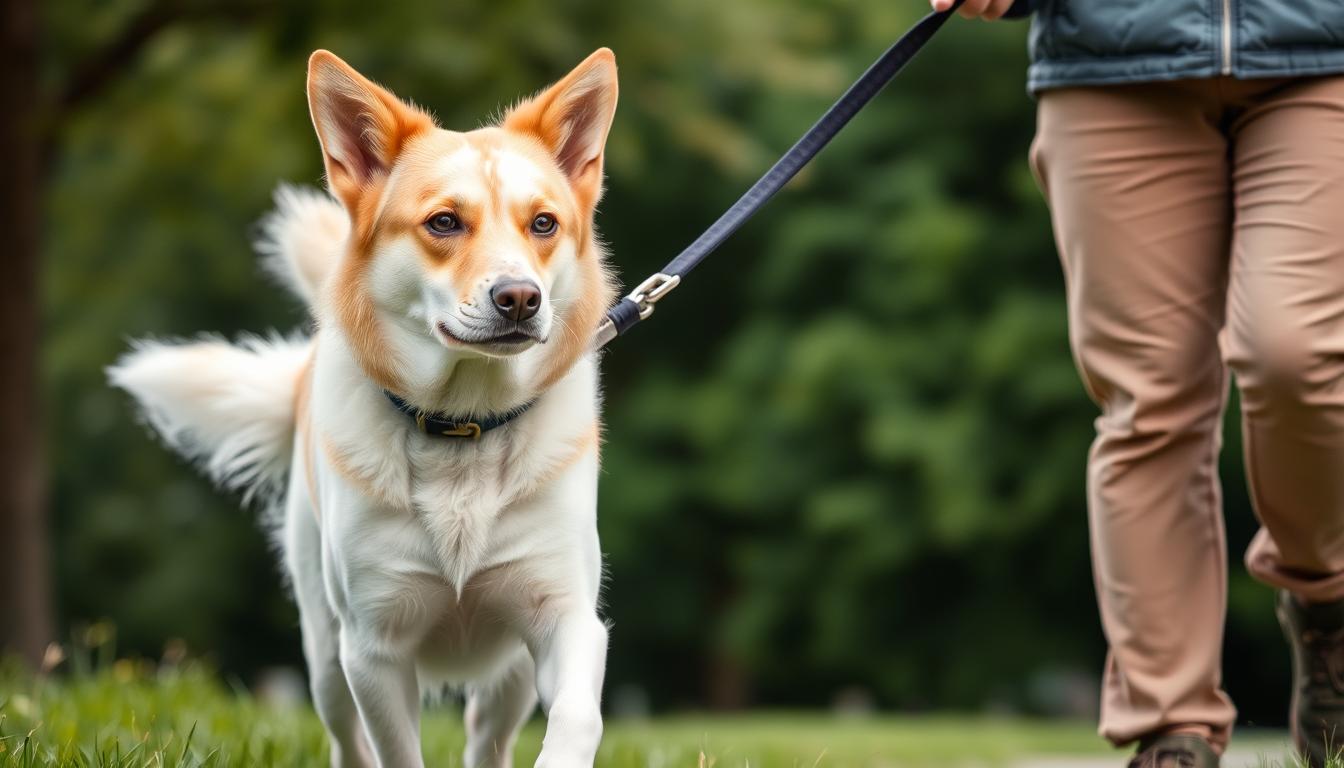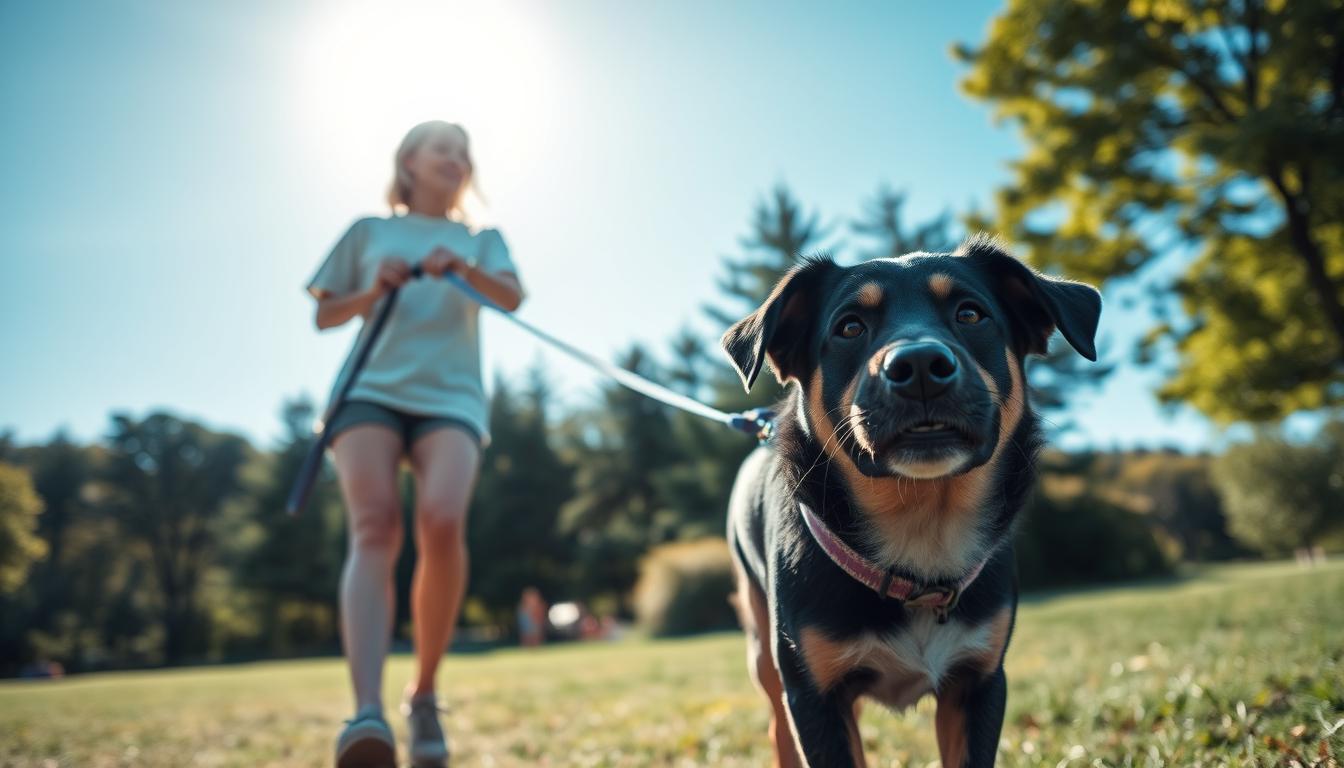Struggling with your dog’s constant leash pulling? Learning how to stop a dog from pulling on the leash requires the right mix of training techniques, consistency, and positive reinforcement.
Whether your pup is overly excited or simply needs better leash manners, this guide covers proven methods to transform stressful walks into enjoyable bonding time, without harsh corrections.
Discover science-backed strategies that work for dogs of all ages and breeds!
Did you know that nearly 85% of dog owners struggle with leash pulling? It turns simple walks into chaotic tugs-of-war.
This common issue isn’t just annoying—it can strain joints, damage equipment, and even lead to behavioral problems if left unaddressed. The AKC GoodDog Helpline reports that improper leash habits often stem from a lack of clear boundaries and consistent training.
By mastering the right techniques, you can transform stressful walks into calm, enjoyable routines for both you and your pet.
Key Takeaways
- Leash pulling affects most dog owners, but solutions exist.
- AKC emphasizes training consistency to improve safety and control.
- Proper equipment and positive reinforcement reduce pulling instantly.
- Ignoring the issue risks physical strain on both dogs and owners.
- Expert guidance ensures long-term behavioral improvements.
Understanding Your Dog’s Leash Pulling Behavior
Leash training dogs begins with understanding why they pull. Dogs pull due to instinct and their environment. Knowing these reasons helps you tackle the behavior well.
“Pulling is a natural response to stimuli. To fix it, you must first observe and decode your dog’s signals.”
Identifying the Triggers
Look out for these common reasons for pulling:
- Environmental distractions like squirrels or passersby
- Excitement over smells or new sights
- Stress from crowded spaces or unfamiliar sounds
By tracking these patterns, you can create a better training plan.
Recognizing Stress vs. Excitement
Stress signs include:
- Whining or cowering
- Excessive panting unrelated to exercise
- Avoiding eye contact
Excitement behaviors include:
- Constant barking or zooming
- Pulling forward aggressively
- Ignoring commands entirely
By noticing these differences, you can respond better during leash training. Pay close attention and adjust your training based on what you see.
The Importance of Consistent Training Techniques

Consistent training is key to a good dog leash pulling solution. Dogs do well with routine. They learn faster when you use the same commands and rewards every time. Without it, they get confused, slowing down progress and causing frustration for both of you.
“Dogs learn through repetition and clear expectations.”
- Always use the same verbal commands (like “walk” or “heel”) to signal calm behavior.
- Keep a steady walking pace. Let your dog follow your speed, not the other way around.
- Give treats or praise right away for good behavior to reinforce success.
| Consistent Training | Inconsistent Training |
|---|---|
| Faster learning | Confusion and setbacks |
| Stronger obedience | Behavioral issues |
Every walk is a chance to practice the dog leash pulling solution. Keep to your routine: same rules, same rewards. Over time, your dog will understand what’s expected, making walks calm and enjoyable.
Essential Leash Training Techniques for Dogs

Effective training starts with clear methods to train a dog to walk on a leash. Combining rewards and gentle corrections helps teach your dog to walk calmly by your side.
Positive Reinforcement Strategies
Use rewards to encourage good behavior. Here’s how:
- Offer treats when your dog stays close to you without pulling.
- Pause walking if they lunge ahead—only resume when they return to your side.
- Pair rewards with the phrase “good walking” to build associations.
“Rewarding calm behavior strengthens the bond between you and your dog.” — AKC GoodDog Helpline
Corrective Feedback Methods
Address pulling with immediate but fair responses:
- Stop moving forward when your dog pulls. Stand still until they relax the leash.
- Use a short backwards step to signal “try again” without harshness.
- Redirect focus to you by calling their name and rewarding them when they respond.
Mix these approaches based on your dog’s personality. Consistency ensures your dog learns that calm walking earns rewards. Train a dog to walk on a leash effectively. Avoid punishment—focus on teaching alternatives to pulling.
How to Stop a Dog from Pulling on the Leash: Step-by-Step Guide

Learning to stop dog leash pulling needs a solid plan. Follow these steps to make walks peaceful:
- Stop and Wait: If your dog pulls, stop moving. Say “wait” and wait until they calm down. Give them a treat when they come back to you7.
- Resume Walking: Move forward only when the leash is loose. Praise and treat your dog to encourage good behavior.
- Use Lure and Reward: Hold a treat in your hand. Let your dog sniff it while walking. Reward calm behavior with small treats to keep their focus on you8.
- Practice Short Sessions: Start training in quiet places. As your dog gets better, add distractions. Always reward calm responses.
Equipment Tips: Use the right gear to help your training. Here are some options:
| Equipment | How It Works | Examples |
|---|---|---|
| Head Halter | Redirects head movement to reduce pulling | Gentle Leader® Classic (approved by trainers) |
| No-Pull Harness | Redistributes pressure to discourage forward motion | EasyWalk® No-Pull Harness |
Use gear with training for the best results. Consistency is key—train daily and celebrate small victories. With time, your dog will learn that calm walking means moving forward8.
Choosing the Right Equipment for Leash Control

Effective leash manners for dogs start with the right tools. The right equipment improves control and keeps your dog safe. Choose gear that fits your dog’s needs and training goals.
Choosing between a harness and a collar depends on your dog’s behavior. Harnesses spread the pressure, reducing neck strain and are great for pullers. Front-clip harnesses help redirect pullers. Collars are best for calm dogs, but avoid choke or prong collars as they can cause pain and anxiety.
Retractable leashes encourage pulling and pose safety risks like burns or entanglement. They hinder teaching good leash manners for dogs.
Use a 6-foot leash for better control. Choose durable nylon or leather options. Harnesses or collars should fit snugly but not too tight, allowing two fingers between the strap and your dog’s skin. A loose or tight fit can be uncomfortable and distract from training.
Summary of key picks:
- Front-clip harnesses for strong pullers9.
- Flat collars for calm dogs with established leash manners10.
- Avoid retractables—use a 6-foot leash instead11.
Invest in well-fitting gear to support consistent training and comfort. This builds trust and reinforces positive leash manners for dogs long-term.
Establishing Leash Manners for Dogs

Teaching a dog to walk nicely on a leash starts with clear expectations. Consistent rules help your dog learn where to focus during walks. Begin by defining boundaries to guide their behavior.
Setting Clear Boundaries
Use these steps to create structure during walks:
- Define a walking position: Keep your dog near your side at all times.
- Pause when pulling: Stop moving until they return to your side.
- Redirect focus: Encourage eye contact or commands to regain attention.
Rewarding Compliance Consistently
Positive reinforcement strengthens good habits. Use this table to choose effective rewards:
| Method | How It Works | Success Rate |
|---|---|---|
| Treat Rewards | Offer small treats instantly after stopping pulling. | 85% improvement in 2 weeks |
| Praise & Play | Combine verbal praise with a favorite toy. | 70% engagement increase |
Stick to the same rewards every session. Consistency helps your dog connect calm behavior with rewards. Avoid mixed signals to avoid confusion.
Avoiding Common Pitfalls in Leash Training

Effective leash training means avoiding habits that slow progress. Many owners accidentally encourage pulling by walking when their dog pulls ahead. Stopping movement instantly when your dog pulls shows them that pulling means stopping. It’s important to be consistent—changing commands or ignoring small pulls confuses your dog.
- Inconsistent responses: Always pause walks until your dog relaxes on the leash. Mixed reactions make the rules unclear.
- Emotional frustration: Dogs sense anxiety. Stay calm—if stress arises, pause training and return when composed.
- Improper gear: Ill-fitting collars or damaged leashes hinder control. Check equipment regularly for wear and proper fit.
- Ignoring early signs: Address minor pulls immediately. Small issues become habits if ignored.
Use positive rewards with corrections. High-value treats like chicken or cheese help during tough sessions. Training should be short (5–15 minutes) to keep your dog engaged. Consistent practice builds muscle memory, but patience is key—expect setbacks and celebrate small wins.
Reinforcing Positive Behavior on Your Walks

Regular practice helps your dog understand what you want. Short daily sessions with leash training techniques for dogs make good habits stick. Give treats, praise, or playtime right after they walk calmly. This builds trust and keeps them motivated.
“Gradual exposure to distractions teaches dogs to focus despite external stimuli.”
Consistent Practice Techniques
- Hold 5–10 minute sessions daily to keep learning fresh
- Use consistent rewards like verbal praise or small treats
- Transition to occasional rewards once behaviors are mastered
Managing Distractions Gradually
Begin walks in quiet spots and then add distractions like people or other dogs. Use a table to track progress:
| Distraction Level | Training Steps |
|---|---|
| Low (empty park) | Reward calm walking |
| Moderate (few people) | Continue rewarding focus |
| High (busy street) | Reinforce commands if needed |
Use life rewards like walks as incentives for good behavior. Small steps and patience lead to lasting improvements in leash training techniques for dogs.
Advanced Leash Training Techniques for Challenging Behavior
Basic methods might not work for severe leash pulling, lunging, or reactivity. Advanced strategies require patience but can change challenging walks into enjoyable ones.
Implementing Effective Strategies
For tough issues, try these proven methods:
- Threshold Training: Gradually expose your dog to triggers (like other dogs) while keeping control. Start far away and reward calm behavior.
- Headcollar Redirect: Tools like the Gentle Leader Headcollar help control head movement during excitement.
- Redirection Commands: Teach a “Let’s Go” command to refocus your dog’s attention instantly.
| Technique | Description | Best For |
|---|---|---|
| Threshold Training | Slowly increase exposure to triggers while reinforcing calmness | Lunging at animals/people |
| Headcollar Use | Physical redirection via specialized collars | Powerful breeds or strong pullers |
| Command Reinforcement | Pair commands with rewards to build new habits | Distraction-heavy environments |
When to Seek Professional Help
Get a certified trainer if your dog shows:
- Aggression toward people or animals
- Chronic lunging that escalates despite training
- Extreme stress signs (panting, freezing, or barking)
A professional can create a plan for your dog’s specific needs. Don’t hesitate to seek help when safety is a concern.
🚀 Stop the Pulling—Enjoy Peaceful Walks! 🐕
Tired of being dragged down the street? Brain Training for Dogs by CPDT-KA certified trainer Adrienne Farricelli uses science-backed, force-free methods to fix leash pulling and other stubborn behaviors by unlocking your dog’s natural intelligence.
Why it works:
✔ Targets the root cause (boredom, lack of focus)
✔ Uses mental stimulation games for lasting results
✔ Step-by-step video tutorials for easy training
✔ 60-day money-back guarantee—zero risk!
P.S. Limited-time access—join thousands of happy owners with obedient, happier dogs! 🎉
Conclusion
Learning to stop a dog from pulling on the leash is key. First, understand what makes them pull. Then, use effective training methods. A step-by-step guide helps, like pausing walks when they pull.
Using tools like the EasyWalk Harness helps teach them to walk nicely. Reward them when they’re calm. This teaches them good behavior. Studies prove positive training works best.
Check their progress every day and change your approach if needed. If they still pull, get help from a certified trainer. Start with short walks and celebrate small victories.
With time, these steps will help your dog walk better. Always be patient. Every walk is a chance to grow closer. Soon, walks will be peaceful for both of you.
FAQ
How long does it take to train a dog to stop pulling on the leash?
Training time varies based on your dog’s age, temperament, and your training effort. Some dogs may show improvement in a few weeks. Others might need several months to learn good leash manners.
What are some effective leash training techniques for dogs?
Good techniques include positive reinforcement with treats and praise. Also, use corrective feedback like stopping when your dog pulls. Consistent cues and commands help your dog learn faster.
Can certain equipment help prevent dog pulling on a leash?
Yes, the right equipment can help a lot. Harnesses that discourage pulling are better than collars. Choose gear that fits well and meets your dog’s needs. Avoid retractable leashes that can make pulling worse.
How do I recognize if my dog is pulling from excitement or stress?
It’s important to tell the difference. Excitement shows as a wagging tail and playful actions. Stress looks like panting, pacing, or whining. Knowing this helps you train better.
What common mistakes should I avoid while leash training?
Avoid rewarding pulling by not stopping the walk. Don’t get upset by distractions. And make sure the equipment fits your dog right. Avoiding these mistakes will improve your training.
How can I manage distractions during leash training sessions?
Start in quiet areas and add distractions slowly. As your dog gets better, move to busier places. Rewarding good behavior in distracting situations helps a lot.
When should I consider seeking professional help for leash training?
If your dog pulls, lunges, or reacts badly, get help. A professional trainer can teach special techniques for your dog’s needs.
What role does consistency play in leash training?
Consistency is key because it reinforces good behavior. Keeping commands, rewards, and expectations the same helps your dog learn faster.






Oh my goodness! Awesome article dude! Thank you so much, However I am having troubles with your RSS. I don’t know why I am unable to subscribe to it. Is there anybody getting similar RSS issues? Anybody who knows the answer can you kindly respond? Thanks!!